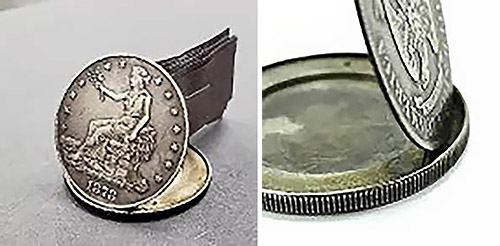Shore Collectibles
By Douglas Keefe
Through the years people have had reason to modify coins minted by the United States mint for their own purpose. This can involve a single change for a persons’ pleasure such as cutting the design from the coin for use as a piece of jewelry or a commercial endeavor such as where some merchants in the 1800’s stamped their names or business names on coins as advertisement. Another example is the love token where craftsmen traveling with fairs and carnivals during the mid/late 1800’s would, for a fee, engrave names, initials or designs on coins, mostly dimes. These are called love tokens as they typically were done to give as a present to ones’ sweetheart.
Another modification involved the Trade dollar, a coin created specifically for use in the orient and to be comparable with the Mexican eight reale coin which was in heavy use due to its consistent silver value. Because the Trade dollar contained a different amount of silver than the regular silver dollar, it was not to be used as legal tender in the United States. It had a short production life, only minted from 1873 until 1878 because it never caught on overseas.
The modification of the Trade dollar I am mentioning involved creating a hidden compartment in the coin. This was done by hollowing out one coin and using a second to provide a lid which was attached by a hinge and could be opened by pressing on the lid or edge. A small spring would pop the lid open. Needless to say this involved some very intricate work because the coins I have seen look normal at quick glance, with the lid fitting tightly to the base.
For many years this was called an opium dollar because it was thought that it could be used to carry a small amount of opium in ones’ pocket undetected. Because these Trade dollars were used in the Asia during the latter part of the 19th century and opium was one of the products traded with China, it was considered that the purpose of the hinged coin was to hide the drugs.
Another not so sinister purpose of the hinged coin was to contain the picture of a wife, child or loved one. A firm, The Busiest House in America, that dealt in collectibles and other unique items during the late 1800’s advertised in their 1896 catalog the coin as a “secret locket”. The use at the discretion of the buyer (my comment). It is unknown if this company was responsible for the production of these coins, but if they were, that would dispel the theory about the coins use as a hiding place for drugs.
There is no way to determine the number of the Opium or Box dollars made, but they are highly collectable with prices in the $400 to $500 range. If you ever come across a Trade dollar that feels a little light, you should check to see if it’s an opium dollar, hopefully with someone’s picture, not the opium, still inside.
Douglas Keith is the President of Beachcomber Coins, Inc. He and his wife Linda operate Beachcomber Coins and Collectibles, formally located in the Shore Mall and now located at 6692 Black Horse Pike, Egg Harbor Township in the old Wawa building. They also have satellite offices for buying only in Brigantine (Saturday), and in Absecon (Tuesday). Between them, they have over 70 years of experience buying and selling coins, collectibles in precious metals. They are members of the American Numismatic Association, the Industry Council of Tangible Assets, the Numismatic Guarantee Corporation, the Certified Coin Exchange and the Professional Coin Grading Service. Visit their website at www.beachcombercoinsinc.com for video and information.






